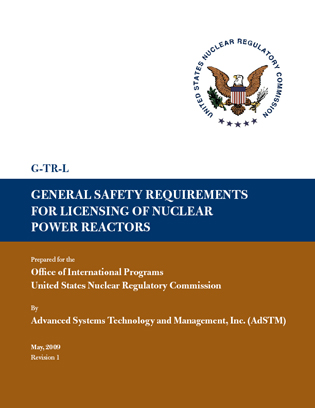G-TR-L General Safety Requirements for Licensing of Nuclear Power Reactors

Table of Contents
- Introduction
- Definitions
- Objective and scope
- Licensing documents and the licensing basis
- Safety objectives, design limits and acceptance criteria
- General plant characteristics
- Safety assessment
- Classification of plant equipment
- Safety requirements for systems, structures and components
- Safety management
- Commissioning and operational programs
Overview
These reactor safety requirements are primarily based on the International Atomic Energy Agency (IAEA) Safety Requirements No. NS-R-1: Safety of Nuclear Power Plants: Design [1] and the Nuclear Regulatory Commission (NRC) Code of Federal Regulation (CFR), 10CFR [2]. In many cases, it includes verbatim language from these regulations and requirements.
These licensing requirements are intended to be implemented by the regulatory agency as binding requirements within the national legal framework. This document is supplemented by detailed guidance in reference G-RG-CP, “Preparation and Review of Applications for Construction Permits,” [3], and G-RG-OL, “Preparation and Review of Applications for Operating Licenses,” (not yet published). These are supported by information in IAEA Safety Guides, NRC Regulatory Guides, and guidance from other international sources; references [4] through [9]. The references describe in sufficient detail how to implement the licensing requirements. They specify the information to be submitted in support of a licensing application, and the approach of the regulatory agency to review that information.
These requirements are intended for stationary nuclear power plants with water cooled reactors, designed for electricity generation or other heat production applications. In the case of other reactor types, including innovative developments in future systems, some of the requirements may not be applicable, or may need some judgment in their interpretation.
